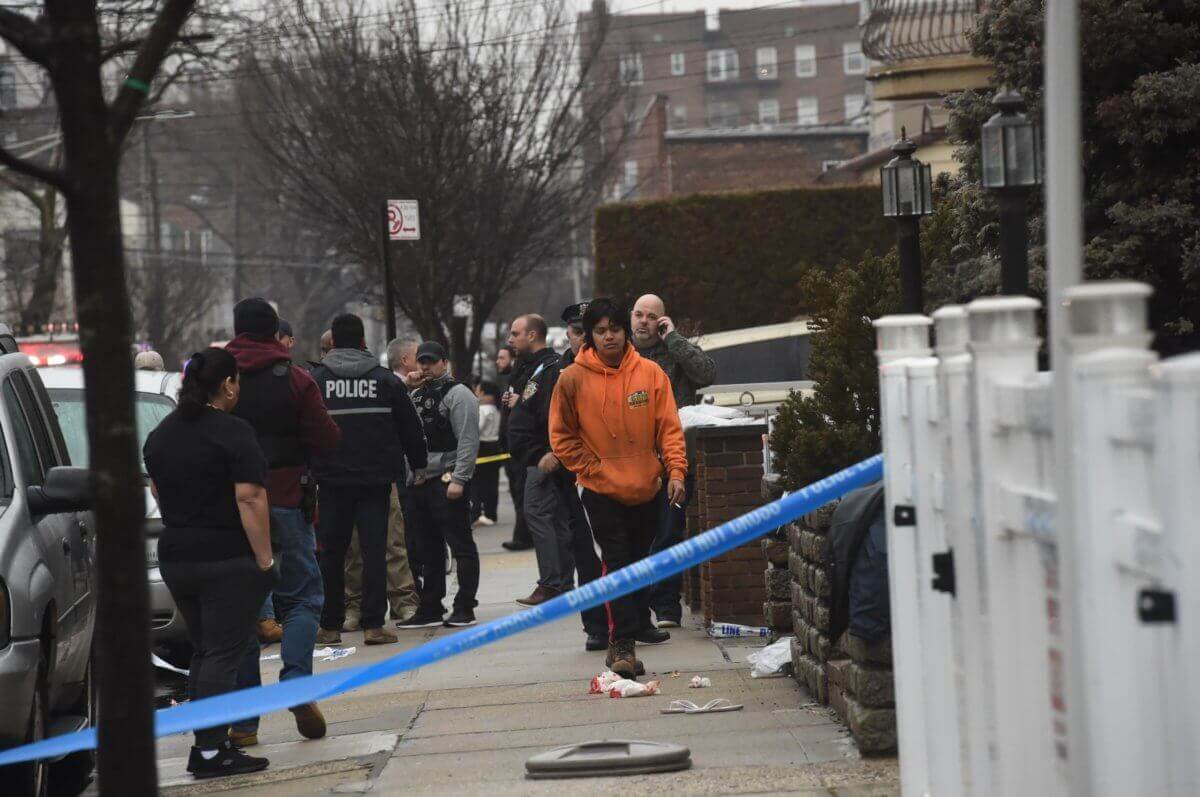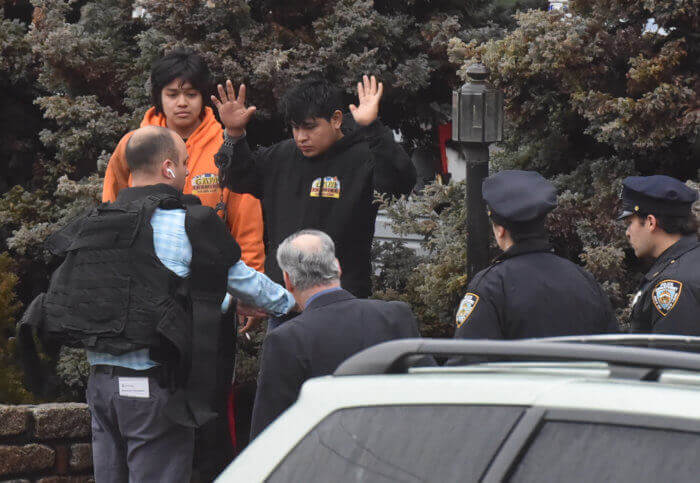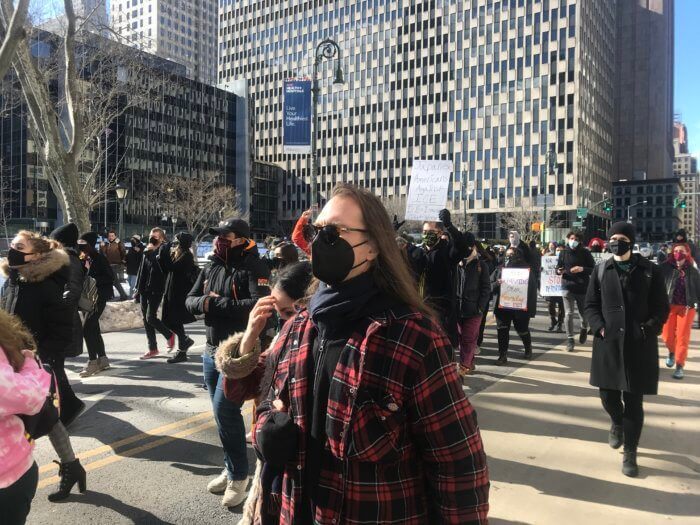Family of Victim Still Seeking Justice One Year After ICE Shooting in Gravesend
The shooting of a Mexican man in Gravesend by Immigration and Customs Enforcement sparked protests and political outrage last February.

Protesters marched from Foley Square to District Attorney Letitia James’ office to protest governmental inaction after the ICE shooting. Photo by Rose Adams
The shooting of a Mexican man in Gravesend by Immigration and Customs Enforcement sparked protests and political outrage last February. But one year later, as the family battles hefty medical bills, they feel their calls for action fell on deaf ears.
“In the name of my family, I’m here asking for justice for my son,” said Carmen Cruz at a protest held this month on the anniversary of the shooting. “My son is still recuperating and my partner is still not completely free.”
Erick Diaz-Cruz, 26, was sleeping in his mother’s home in Gravesend on Feb. 6, 2020 when federal immigration agents knocked on the door. Cruz — who was visiting his mother from Mexico on a valid tourist visa — rushed outside, where plainclothes agents claiming to be New York City police officers were trying to arrest his mother’s long-term partner, Gaspar Avendaño-Hernandez.

Minutes after Diaz-Cruz confronted the agents, one officer pulled out a gun. Diaz-Cruz covered his face with his hands before the officer fired at him from only a few feet away, sending the bullet through his hand and into his left cheek, according to court filings.
One witness said at the time that the shooting seemed unwarranted.
“He was right there and the officer pulled a gun, and shot the guy. It just didn’t look professional. He wouldn’t tell the guy why they were arresting him,” said Avi Zlita, who still had blood on his sleeve after tending to Diaz-Cruz after the shooting.
An agent also tased Avendaño-Hernandez between 15 and 20 times as he resisted their attempts to cuff him, according to Avendaño-Hernandez’s lawyer and the victim’s brother. Both victims were unarmed.
ICE said they targeted Avendaño-Hernandez, 36, after a recent traffic stop by the NYPD, and that he had been deported twice before and had a 2011 assault conviction.

Emergency personnel transported Diaz-Cruz and Avendaño-Hernandez to Maimonides Medical Center in stable condition. Inside the hospital, ICE officers prevented relatives and legal counsel from seeing both men, Carmen Cruz later testified, and it wasn’t until the Mexican Consulate General intervened that she saw her family that night.
After Avendaño-Hernandez was released from the hospital, federal agents detained him with the help of the NYPD — a potential violation of the city’s sanctuary city policies — Diaz-Cruz’s mother, Carmen, said in an emotional testimony.
“Finally, when the moment came that the federal authorities wanted to kidnap my partner, we saw other officials from this city, police from New York City, come out to help. But instead of helping and protecting those who were the victims of a crime, my partner and my family, they came out to help the federal government,” she said in Spanish during a Feb. 28 hearing held by the City Council. “This needs to be investigated.”
Looking for answers
The incident sparked protests outside the hospital and outrage from elected officials. Brooklyn Congressmembers Jerrold Nadler and Nydia Velazquez wrote a joint letter demanding that the agency brief them on the shooting, and the City Council held an emergency four-hour hearing where Cruz testified. None of the efforts, however, produced legislation or a city-led investigation.
Activists have called on Attorney General Letitia James to investigate the incident and certify the shooting and tasering as crimes. Such a certification would make Diaz-Cruz and Avendaño-Hernandez eligible for U Visas, which would allow them to stay in the US legally, their lawyers said.
Attorney General James’ chief of staff agreed to meet with the family and discuss the incident after it happened, but staffers never scheduled a meeting, a text conversation between the staffer and activist Jorge Muñiz-Reyes reveals.

When reached for comment, a spokeswoman for James said that only the district attorney has the jurisdiction to investigate the crime, though she declined to explain why the incident lies outside the attorney general’s purview. The Brooklyn District Attorney’s office did not respond to multiple requests for comment.
Meanwhile, Diaz-Cruz has undergone extensive facial reconstructive surgery and has two more surgeries planned, his mother said, adding that the medical bills have exceeded $300,000. The now 27-year-old is at least partially blind in his left eye, according to his lawyer, Gabriel Harvis with Elefterakis Elefterakis & Panek, and has lost mobility in his hand and arm.
Avendaño-Hernandez is seeking follow-up treatment for heart irregularities detected after the tasering, said his lawyer, Hannah McCrea with the Brooklyn Defenders Services. He was released from ICE custody in April because of COVID-19, and is being monitored by federal authorities. He is awaiting a court date on his removal proceedings, and his habeas corpus petition is pending, McCrea said.
Diaz-Cruz’s lawyers have filed a claim against ICE alleging excessive force and are preparing to file an FTCA claim alleging negligence. Harvis said he doesn’t know whether the ICE officer who shot Diaz-Cruz, now identified as officer Henry Santana, has faced any disciplinary action, but said there is a federal investigation underway.
“We do know that there’s some sort of ongoing review. We don’t know at this time whether it’s an internal disciplinary action or criminal proceedings,” Harvis said.
The Department of Homeland Security’s Office of Inspector General, which is conducting the investigation, declined to comment. ICE also declined to comment.
During Saturday’s protest, a Sunset Park lawmaker denounced the NYPD for apparently aiding the ICE agents in their efforts to detain Avendaño-Hernandez.
“I was there from the very beginning to the end of that night, and I watched the government protect the institutionalized and racist and terror organization of ICE,” said Council Member and mayoral candidate Carlos Menchaca. “NYPD didn’t even try to protect the two that were injured that day.”
Under the city’s sanctuary city policies, the New York police force is barred from cooperating with ICE for detainer requests, except in case of violent crimes. However, all NYPD arrests are shared with the state and then sent to the Federal Bureau of Investigation and ICE, which often uses that arrest data to track undocumented residents down.
Protesters marched from Foley Square in Lower Manhattan to Attorney General James’ office in Downtown Brooklyn to demand government action. Even if James and local lawmakers don’t investigate the ICE shooting themselves, they could look into the NYPD’s cooperation with the federal immigration agents, activist Muñiz-Reyes argued.
“The NYPD was almost as involved [as ICE]; they did everything but pull the trigger,” said Muñiz-Reyes. “It was New York police that arrived shortly thereafter, and instead of helping a victim of the crime, actually assisted the ICE agents in arresting Gaspar and driving the ICE agents to the hospital.”
Muñiz-Reyes blasted the lawmakers and the local and state prosecutors for their lack of involvement.
“They’re pointing fingers at each other,” he said.
Editor’s note: A version of this story originally ran in Brooklyn Paper. Click here to see the original story.
Related Stories
- Locals on Edge After Warnings of Possible ICE Raids in Fort Greene, Red Hook
- Association of Legal Aid Attorneys Plan Rally to Keep Immigration Arrests Out of Courts
- Brooklynites Call for End to ‘Child Concentration Camps’ at Borough Hall Rally Thursday
Sign up for amNY’s COVID-19 newsletter to stay up to date on the latest coronavirus news throughout New York City. Email tips@brownstoner.com with further comments, questions or tips. Follow Brownstoner on Twitter and Instagram, and like us on Facebook.









What's Your Take? Leave a Comment